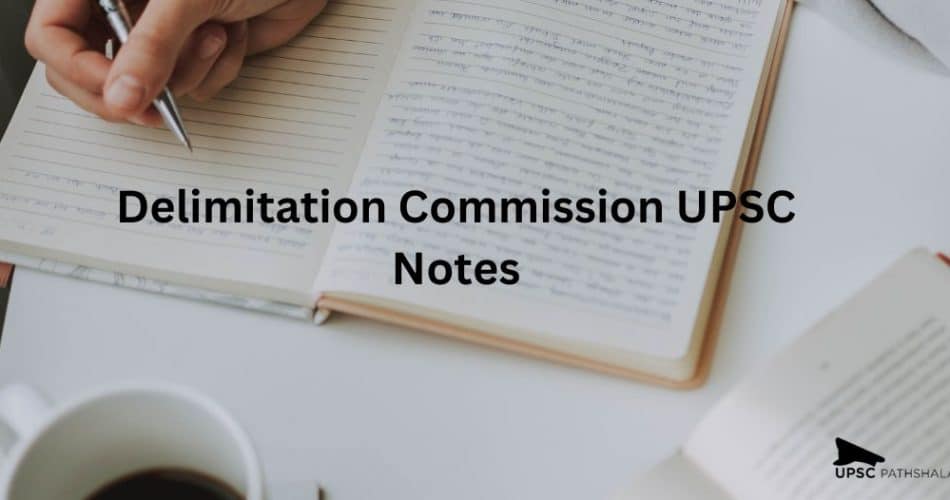The UPSC polity notes are covered in this article. Also, go through the information about the delimitation commission and the UPSC IAS coaching online. Let’s check out the details now!
Also Read: UPSC Calendar 2023: Must know Things about Civil Service Exam
Delimitation Commission – UPSC Notes
The Delimitation Commission is a high-position body set up by an act of Parliament. It’s appointed by the country’s President. A sheltered judge of the Supreme Court. The Chief Election Commissioner State Election officers of the separate countries. Its orders can not be questioned in a court of law.
The clones of the orders are laid before the Lok Sabha and the legislative assemblies concerned, but no change is permitted in them. The Delimitation Commission determines the number and boundaries of constituencies in such a manner that the population of all seats is the same, as far as virtually possible.
The Commission also identifies the seats to be reserved for the listed gentries and listed lines communities, in areas where their population is significant. However, the decision of the majority will also be taken into consideration. If the members of the Commission have differing opinions.
The Commission releases draft proffers to the public through the review of India and the sanctioned books of countries, and also in indigenous language newspapers. It also conducts public sittings wherein the public’s opinion is heard through written or oral representations. However, changes are made to the draft offer, If set up applicable.
Also Read: 10 Reasons to Choose IAS as your Dream Career: Let’s Have an Understanding of IAS Preparation!
UPSC Polity Notes
The final order is published in the Books and comes into effect by a date specified by the President. It shall be the duty of the Commission to readjust the representation of the several territorial constituencies in the House of the People and of the several territorial constituencies in the Legislative Assembly of each state on the basis of the rearmost tail numbers of the population. Delimitation Commissions in history.
The first delimitation exercise was conducted by the Indian President(with the help of the Election Commission) in 1950- 51. The Delimitation Commission Act was legislated in 1952. Because of the delimitation process, countries that haven’t achieved any significant strides in reducing their population could end up with larger figures of seats in the Parliament. In 2008, delimitation was grounded on the census of 2001, still, the total number of seats in the Parliament and the Legislative Assemblies fixed as per the census of 1971 wasn’t changed.
Another problem is that the Constitution of India has put a cap on the maximum number of seats in the Lok Sabha to 550 and Rajya Sabha to 250. So, because of delimitation, an adding number of populations are being represented by a single representative.
Also Read: Best UPSC CSE Prelims and Mains Smart Courses: Let’s Prepare Perfectly for the Exam!
UPSC Preparation
An amendment has been laid over the lifting of the cap on the maximum seats in the congress to the time 2026, on the grounds that an invariant growth rate of population would be achieved by 2026 throughout India. The Delimitation Commission of India has been regarded to have absolute governance, and rulings set by this commission can not be challenged by any courts or legislation. Still, these directives of the Indian Delimitation Commission have been shown to be enforced as of a certain date indicated by the President of India.
The Delimitation Commission is a panel with legislative backing that operates singly of the government and political parties. It determines the number and boundaries of constituencies in order to have a population that’s nearly equal in all constituencies. Identifies seats reserved for slated Castes and slanted lines in areas with a sizable population. Review countries that aren’t concerned about population control may end up with further seats in Parliament.
The southern countries that promoted family planning risked having their seats reduced. Delimitation was done in 2008 based on the 2001 tale, but the total number of seats in the Assemblies and Parliament decided in 1971 wasn’t changed.
UPSC Notes
The constitution also limits the number of Lok Sabha and Rajya Sabha seats to the outside of 550 and 250, independently, and growing populations are represented by a single representative. To resolve issues before 2026, a public consensus exercise should be launched. The weightage given to the population by the Finance Commission can be reduced to 10 or indeed 5. Based on 2011 Census data, it’s estimated that when administrative constituency boundaries are redrawn, the Lok Sabha’s strength will increase from 543 to 888. The Rajya Sabha’s number could rise to 384 from the current 245.
Also Read: 5 Reasons to Join Online IAS Coaching: Let’s Find the Best Coaching for IAS!
Conclusion
Therefore, you should visit the UPSC Pathshala website to get the details about the exam. Join the UPSC IAS coaching online now!







